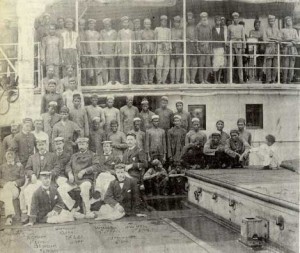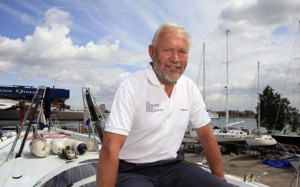
There are several striking differences between the Laskari dictionary of Lt Thomas Roebuck[i] and Anthony Vaz’s Vocabulary Of Nautical Terms[ii]. The most important perhaps is that Roebuck was attempting to make the case that ‘Laskari’ was, if not a language, then certainly a dialect in its own right, created out of the merging of many different languages – Arabic, Portuguese, English, Bengali, Malay, Malayalam, Tamil, Kachhi and so on (although a few Marathi words figure in his dictionary I cannot remember any specifically Konkani terms). But Vaz does not anywhere acknowledge or use the term ‘Laskari’ – the very word ‘lascar’ does not figure in his book. This is probably because this word had, by the late nineteenth century, acquired pejorative racial connotations: as a seaman himself Vaz would have been acutely aware of these overtones. Such indeed was the stigma attached to the word ‘lascar’ that it more or less fell out of usage after the Second World War.
Throughout his dictionary Vaz insists that the language of Indian seamen is Hindustani, except for the ‘technical names’ which, he asserts ‘are all Arabic in their origin’. In this he was mistaken: many of the words for the rigging, masts, sails etc. came from other languages, especially Portuguese. For example, the Laskari word for ‘mizzen-sail’ was trikat which comes from the Portuguese traquete. Similarly, taliyamar, the Laskari word for ‘cutwater’ came directly from the Portuguese talhamar. There are innumerable such examples.[iii]
Vaz was not an etymologist of course, but even then it remains something of a puzzle that he should have been unaware of the Portuguese influences on the nautical vocabulary of the Indian subcontinent.
Unlike Roebuck, Vaz was in the first instance, a seaman and one interesting aspect of his dictionary is that its organization is dictated by practical, rather than lexical considerations. In effect the book is a compendium of the commands that are necessary to the operation of a sailship, and they are divided according to certain tasks: for example ‘Launching of the Ship’, ‘Making Sails When Fine Daylight’; ‘Bracing Yards in Calm When Wind Not Steady’, ‘Setting and Taking Studding Sails When Fine Steady Breeze.’
The reader may be interested here to look at some of the commands and their glosses. Here are a few:
From ‘Launching of the Ship’:
– All Hands clean clothes on board – sab admee saf kupray payno
– Cock well the anchor – lungur cock well karo
– Take in the ballast – leelum layo
From ‘Setting Trying Sails and Spreading the Awnings’:
– Clew up the royal, gallant sail and top sails, fore and aft – stringee tubber, subber gabee agul pitchel
– All your clewline, buntline and leechline close up – chop stringee buntline seesee door cheekar
From ‘Bracing Yards About in Calm When Wind Not Steady’
– Square the main yard – Yam burra purwan
– Haul out the spanker – tan bar ghoosee
From ‘Setting and Taking in Studding Sails When Fine Steady Breeze’
– Topmen aloft – Panjrawala oopur jao
– Set the fore top gallant studding sail – hankar trinket subber dustoor
Today the English commands are no more comprehensible than their translations. This is of course because every sailship was, in a sense, a vast, floating dictionary, with thousands of named parts – every rope, gasket, leech and pin had its own name. With the vanishing of wind-powered merchant vessels, this entire apparatus (of words as well of things) has more or less disappeared from the face of the earth.
But the Laskari language has not vanished without trace. On subcontinental ships – and I mean naval vessels as well as cargo ships – words like ‘serang’ and ‘tindal’ are still very much in use. For all I know the words may still be in use in other parts of the Indian Ocean – for example, east Africa, Indonesia, Malaysia and elsewhere.
Earlier this year, in Goa, I had the good fortune to meet a man who had actually used the Laskari language:

Sir Robin Knox-Johnston, the first man to complete a solo, non-stop circumnavigation of the world in a sailboat.
Sir Robin began his sailing career in a merchant shipping company in pre-Independence India: he told me that he remembered using Laskari terms like agil/agul (fore) and peechil/pitchel (aft). He confirmed to me that those words were pronounced exactly as they are transcribed in Laskari dictionaries (I had wondered whether they might be mis-spellings of agey and peechhey – I suppose they are variants, borrowed perhaps from a Kachhi dialect).
Sir Robin also confirmed that the kasab of Laskari dictionaries referred to ‘a lamplighter’, which was an important function on the ships of his youth. I asked him about the word bhandari which I had thought meant ‘storekeeper’, but he told me that it actually referred to a ship’s cook.
Another Laskari word that I had puzzled over was topaz. Sir Robin confirmed to me that it meant ‘sweeper’ – a strange fate for a word that once referred to Portuguese-Goan artillerymen, who were greatly valued by the subcontinental armies of the 18th century.[iii]
[i] Roebuck, Capt. Thomas: A Laskari Dictionary Or Anglo-Indian Vocabulary Of Nautical Terms And Phrases In English And Hindustani, revised and corrected by George Small, W.H.Allen & Co., London, 1882.
[ii] The Marine Officer’s Hindustani Interpreter Containing A Vocabulary Of Nautical Terms, Directions For Masting, Rigging And Working Ship At Sea, (Bombay Gazette Steam Press, Bombay, 1879).
[iii] Cf. Soares, Anthony Xavier.: Portuguese Vocables in Asiatic Languages from the Portuguese Original of M.S.R. Dalgado (translated into English with Notes, Additions and Comments), Asian Educational Services, New Delhi & Madras, 1988, pp. 350 & 340.

Good afternoon again, and in context with the blog post above, “bhandari” was and still is the term used for the crew cook while “topas/topaz” was the term used for the person who cleaned the latrines (and not the bathing arteas).
I hope this helps.
best/Veeresh
Thanks Veeresh!
Amitav
Fabulous article! Love the floating dictionary of history…. What would be interesting is to see at what point in time these different languages enter the lexicon, leading to an “archaeology of seawords”–following Michel Foucault. Digging into the time of when the words were introduced, would surely show an interesting pattern of how all these different cultures interacted with the English world.
I am always intrigued at the proliferation of Arabic and Persian words used in the Nepali government, specifically to refer to words related to government. Surely that says something about where notions of governance originated, in the context of Nepal.
And if I’m not mistaken, “kitaab” is also an Arabic word. Not that manuscripts did not exist before the word “kitaab” got introduced to South Asia–but perhaps there was a definitely break from the palm leaf manuscript and daphne paper to the more bound-and glued, two paged artifact we call the “book” which made the definitively leap from pandulipi to kitaab.
Sharing with my linguist friends 🙂
sushma